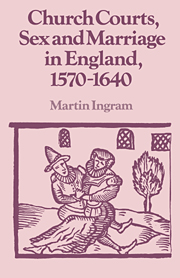Book contents
- Frontmatter
- Contents
- List of tables
- List of maps
- Preface
- Conventions and abbreviations
- Introduction
- PART 1 THE LEGAL AND SOCIAL BACKGROUND
- PART 2 SEX AND MARRIAGE: THE PATTERN OF PROSECUTIONS
- 5 Matrimonial causes: (i) the breakdown of marriage
- 6 Matrimonial causes: (ii) marriage formation
- 7 Prenuptial fornication and bridal pregnancy
- 8 Incest, adultery and fornication
- 9 Aiding and abetting sexual offences
- 10 Sexual slander
- PART 3 CHURCH COURTS AND SOCIETY
- Bibliography
- Index
- Past and Present Publications
8 - Incest, adultery and fornication
Published online by Cambridge University Press: 24 September 2009
- Frontmatter
- Contents
- List of tables
- List of maps
- Preface
- Conventions and abbreviations
- Introduction
- PART 1 THE LEGAL AND SOCIAL BACKGROUND
- PART 2 SEX AND MARRIAGE: THE PATTERN OF PROSECUTIONS
- 5 Matrimonial causes: (i) the breakdown of marriage
- 6 Matrimonial causes: (ii) marriage formation
- 7 Prenuptial fornication and bridal pregnancy
- 8 Incest, adultery and fornication
- 9 Aiding and abetting sexual offences
- 10 Sexual slander
- PART 3 CHURCH COURTS AND SOCIETY
- Bibliography
- Index
- Past and Present Publications
Summary
The major sexual sins had traditionally been a staple of disciplinary prosecutions in the church courts. This pattern continued under Elizabeth and the early Stuarts, apparently with a large measure of support from local interests and in accord with the wide spectrum of lay and clerical opinion which held that the public discipline of sexual offenders was essential to the well-being of the commonwealth. But not all sexual offences were equally liable to prosecution, while within the broad pattern of continuity some changes are visible in this field in the period 1570–1640. The following analysis establishes the range of ecclesiastical discipline over sexual offences, discusses the nature of the cases which did come before the courts, and traces trends over time in the volume of prosecutions. After rising to a peak in the reign of James I, cases diminished in the two decades preceding the civil war, a decline which reflected a real fall in the incidence of bastardy cases and, probably, other sexual offences. The exercise of ecclesiastical discipline was by no means the only factor involved; but the church courts can claim some credit for helping to bring about this perceptible shift in the moral climate.
Brian Woodcock wrote of the ‘great weight of cases of immorality which burdened the courts’ in the diocese of Canterbury in the fifteenth century. The same remark could be applied to any church court jurisdiction in England in the late sixteenth and early seventeenth centuries.
- Type
- Chapter
- Information
- Church Courts, Sex and Marriage in England, 1570–1640 , pp. 238 - 281Publisher: Cambridge University PressPrint publication year: 1988



